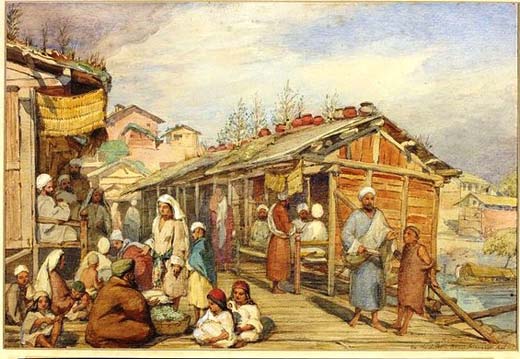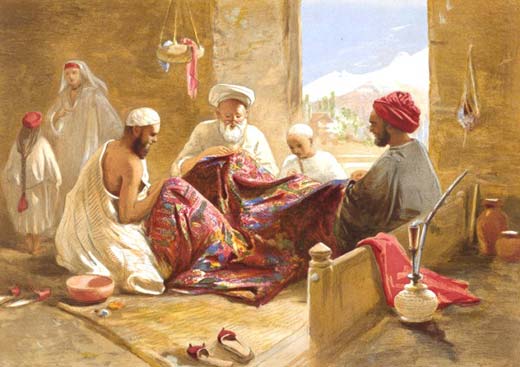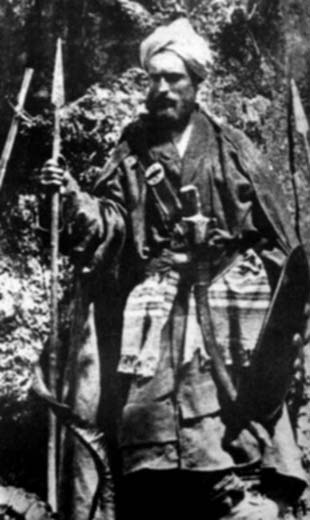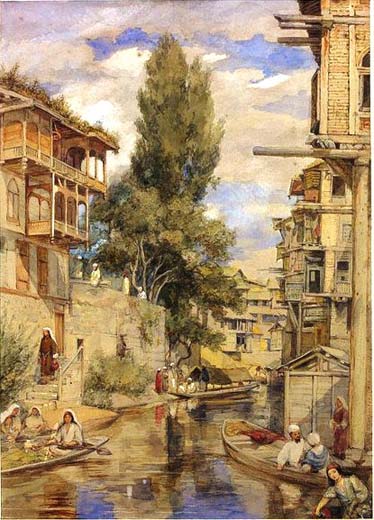Almost 145 years after his murder when the civil society is planning to create a memoriam for Robert Thorp, historian Ashiq Hussain Bhat writes obituary of an activist who is Kashmir history’s foremost civil libertarian

On November 22, 1868 Lieutenant Robert Thorp was found dead in mysterious circumstances in Srinagar’s Kohi-Suleiman foothills. He had been murdered. However, he was not the only British who was assassinated in Kashmir State during 1860s.
British George Jonas Whitaker Hayward (1839–1870), a military intelligence agent, was killed on July 18, 1870 by the men of Mir Wali, chief of Yasin principality. Hayward had, during a previous trip to the Gilgit region, exposed the war crimes of Maharaja Ranbir Singh’s Dogra troops which they had committed in Yasin between 1860 and 1863. Hayward sent details of Dogra atrocities to Calcutta newspaper The Pioneer which it published under his name.
Dogra troops had indulged in wholesale massacre of Yasinis including “tossing babies into the air and cutting them in half as they fell” (p 340 The Great Game by Peter Hopkirk). Hayward had done Yasinis a service by exposing Dogra bloodletting against them. Yet the Yasin Chief got him killed. The finger of suspicion was raised against Ranbir Singh (birth August 1830 – death September 12, 1885) of Kashmir and Mehtar Amanul-Mulk of Chitral. Hayward was the first person who was buried in Gilgit Christian cemetery. Interestingly, Maharaja of Kashmir had paid for his tombstone!

Hayward was to Gilgit what Robert Thorp is to Kashmir. In November 1868, Lt Thorp, aged 30, was strangled to death. Dr Caylay, Ladakh Agent, who was in Srinagar at the time, examined the body and reported “rapture of heart” as the cause of death. Again, the finger of suspicion for the assassination was raised against Ranbir Singh (who had more than one reason to be annoyed with Lt Thorp).
British India Government desisted from taking any action against Ranbir Singh because he had served them in good stead during 1857 mutiny. Not only did he furnish troops and money to their war effort he also went personally to fight against Indian freedom fighters whom he later described in a letter to the British Government of India as “faithless bastards”(pp 47 Maharaja Ranbir Singh by Sukhdev Singh Charak).
Lt Thorp initially came to Kashmir as a tourist and a hunter of big game. Soon, his attention was diverted towards the sorrows of Kashmiri Muslims who were labouring under the worst kind of misrule that they had ever witnessed (p 223 Kashmir in Sunlight and Shade by Tyndale Biscoe). Since his own mother had been a Kashmiri Muslim, he felt a brotherly feeling towards the abject subjects of Maharaja. His father, Colonel Thorp, had married Jana of Tosa Maidan belt. So he made it his business to study and expose the pattern of misrule unleashed against them by Ranbir Singh and his agents.
Those days Englishmen were allowed to stay in Kashmir only for summer months – from April to November. So Lt Thorp was constrained to visit Kashmir during summers to complete his research on Kashmir misgovernment. Later, he brought the miserable condition of Kashmiri Muslims into the notice of Governments of India and England by publishing his findings. His research Cashmere Misgovernment continues to be a major historic document of what happened to Kashmiri Muslims.

Ranbir Singh was a bigoted Hindu who had absolutely no sympathy for Kashmiri Muslims, constituting majority of his subjects. For his own co-religionists he opened Sanskrit schools and raised temples in and around Jammu city, the most prominent among them being the Ragunath temple complex with its Sanskrit school. Moreover, he spent huge amounts of money on the maintenance of foreign Hindu religious establishments such as at Haridwar, Kashi, Prayag, Badrinath, etc.(pp 278-9 Maharaja Ranbir Singh by S S Charak). For the miniscule Kashmiri Pandit minority, he built temple complexes throughout Kashmir including Martand, Bijbehara, Pampore, Khir Bhawani, Gadadar, Sharika, Sharda, (p 280 Maharaja Ranbir Singh by S. S. Charak).
The huge expenses thus incurred were extracted from poverty stricken Kashmiri Muslims in the shape of temple tax, Sanskrit tax and other taxes. Even prostitutes and grave diggers were taxed heavily (pp 130-31 Maharaja Ranbir Singh by S S Charak). A prostitute was disallowed to change her profession. If a starved coolie carried the luggage of a traveler in Kashmir Valley, he had to surrender half his earning to Maharaja’s coffers. Likewise houses, marriages, cattle, beasts of burden, grazing, were taxed to the maximum (p 133 Maharaja Ranbir Singh S S Charak).
Kashmir State under Ranbir Singh was a kind of bania shopkeeper, who reserved a monopoly on the sale of grain. The State collected grain from tillers and stashed it away in storehouses and then sold it to city folk. Even if people had money they could not buy grain beyond a certain limit with the result they were forced to go hungry for considerable part of the year. The State allowed the grain to rot on the threshing floors and in storehouses rather than allowing people to eat it. Also the State did not allow trade between city and village folk. Likewise, the State enjoyed monopoly on silk, saffron, the aromatic root called koth, opium poppy, narcotic drug marijuana (bhang / charas), paper, tobacco, salt, minerals, fruit trees, timber (pp 131 and 298 Maharaja Ranbir Singh by S S Charak).

The State taxed shawl industry to the extent of 85% and land produce to the extent of 75%. At harvest time Maharaja’s agent called Shakdar closely watched the crops lest the tiller might “steal” part of the produce. This Shakdar falsely accused him of stealing part of the crop. The poor fellow thought it better to bribe the agent rather than get involved in a case of theft.
Also Kashmiri Muslim was taken on Begaar – the forced labour, to Gilgit and Astor to carry ammunition and grain for Dogra troops. He was not allowed to touch the grain that he had grown and was now carrying on his back on treacherous mountain passes even if he died of starvation en route (pp 73-76 Cashmere Misgovernment: Kashmir Papers Robert Thorp).
During famines, which recurred in Kashmir Valley at regular intervals, Kashmiri Muslims perished like flies because of the wrongs of durbar. At such times his agents would search Kashmiri Muslim households to check if they were hiding grain. They kept a strict vigil on starving Muslims lest they might indulge in cow slaughter which was punishable by death – the death being meted out by boiling him in oil and hanging his fried remains from a pole for vultures to feast upon (p 119 Kashmir in Sunlight and Shade by Tyndale Biscoe); or they might resort to fishing – fishing being banned since the death of Maharaja Gulab Singh in August 1857. The reason for banning fishing was that late Maharaja’s spirit had taken its abode in the body of a fish in Kashmir, so said the Brahmins at that time.

During 1865 famine three Kashmiris Muslims were sighted by an English traveler on the bank of River Jhelum where they had been kept for three days and nights wearing stinking fish around their necks in the shape of garlands. Their crime was that they had violated the ban on fishing (p 30 Wrongs of Cashmere Kashmir Papers by Arthur Brinkman).The net result was that population of Kashmir Valley progressively dwindled throughout Ranbir Singh’s rule (1856 – 1885) as his coffers swelled.
Whereas the Maharaja encouraged and funded Sanskrit learning among Hindus he did nothing for the education of Kashmiri Muslims who filled his coffers by paying him taxes. On the contrary when Ahli-Hadis preachers started educating Muslims in Shopian Ranbir Singh persecuted them ruthlessly and hounded them out (p 285 The Valley of Kashmir by Walter Lawrence).
It was this tyranny that became the focus of Lt Thorp’s attention. He studied how Ranbir Singh’s agents, mostly Kashmiri Pandits, fleeced Kashmiri Muslims and who these agents were. They included: the Dum (a sort of policeman); Harkara (informer); Tarougdar (revenue official responsible for weighing of State share of land produce); Shakdar (watchman of crops); Sargowl (head of 10 Shakdars); Kardar (collector of land revenue); Patwari (record keeper of houses and land cultivated); Mukadam (village headman and assistant to Patwari); Thanedar (police officer and magistrate with power to inflict corporal punishment); and above all the Tehsildar, officer of a district, (pp 50-52 Cashmere Misgovernment Kashmir Papers Robert Thorp).

Tehsildar reported directly to the Governor. Those days the Governor of Kashmir was the dreaded Kripa Ram, the author of Gulabnama, and Gulzar-i-Kashmir. He also was a bigoted Hindu and is credited with the authorship of an anti-Islam book titled Raddi-Islam (The Rejection of Islam). It was with his support and assistance that Pandit Raja Kakh Dhar, Daroga Dagshali, Chief of Shawl Department, drowned 28 shawl workers at Zaldagar Srinagar on April 29, 1865 for demanding permission to buy more rice to eat. They were expected to work and pay huge taxes but at the same time they were not allowed to buy sufficient rice to feed their families.
Robert Thorp published the details of how shawl industry worked; and of the extortionate taxes levied on it; and also of shawl workers’ massacre to the outside world (pp 62-66 Cashmere Misgovernment Kashmir Papers by Robert Thorp).
Apart from exposing the tyrannical rule of Maharaja, Robert Thorp also exposed and protested against his imperial adventures. It so happened that in 1861 the Muslims of Eastern Turkistan (called Sinkiang since 1884) rose up in rebellion against Chinese authorities. When the Muslim insurrection spread throughout the province an adventurer called Buzurg Khan returned from exile in the Western Turkistan Khanate of Khokand. He was accompanied by his protégé Yaqub Beg. It was January 1865 (p 322 The Great Game by Peter Hopkirk). Within two years time Yaqub Beg managed to wrest Kashgar and Yarkand from the Chinese as well as from local rebels. He installed his patron Buzurg Khan as the King of what now came to be called as Kashgaria.
Taking advantage of the unrest and political uncertainty in Eastern Turkistan, Ranbir Singh dispatched in 1864 a small force across Karakoram Pass sixty miles deep inside to Shahidullah (now called Xaidulla) located on Leh-Kashgar caravan route (p 22 Kashmir: A Disputed Legacy by A. Lamb; p 203 Maharaja Ranbir Singh by S S Charak). There they set up a fort on the left bank of river Karakash.
A British surveyor of the time called W H Johnson, who had a nexus with Ranbir Singh, showed the northeastern frontier of Kashmir State on official British Indian maps some hundred miles away into the trans-Karakoram region to cover Shahidullah garrison. This measure on his part extended Kashmir State by some 21000 square miles of territory including Shaksgam Valley and Aksai Chin wasteland (p 23 Kashmir A Disputed Legacy by Alister Lamb).
Thorp protested through his write-ups that occupation of Shahidullah was a violation of Treaty of Amritsar because the boundary of Kashmir State, according to British perceptions, lied along the Karakoram watershed. In 1867 Ranbir Singh recalled Shahidullah garrison. Later that year Yaqub Beg’s troops pillaged and destroyed the Shahidullah fort (p 89 Cashmere Misgovernment Kashmir Papers by Robert Thorp).
Ranbir Singh’s occupation of Shahidullah for some years and subsequent Johnson mapping set up a sort of fake claim for Maharaja Ranbir Singh on territory which belonged to Eastern Turkistan. Post-1947, the Shahidullah occupation and Johnson map became the root cause of bloody dispute between India on one side and Pakistan and China on the other side over Shaksgam and Aksai China.
For the service that Johnson thus rendered, Ranbir Singh rewarded him in 1872 by appointing him Waziri-Wazarat, Governor of Ladakh; but Robert Thorp, who challenged his claim on trans-Karakoram region; and proposed to the British Government of India outright annexation of Kashmir as a punishment, had to suffer assassination. He was murdered, allegedly by Ranbir Singh’s agents, in 1868. He lies buried in the Christian cemetery of Sheikhbagh Srinagar, just a stone’s throw from Ganta Ghar.















